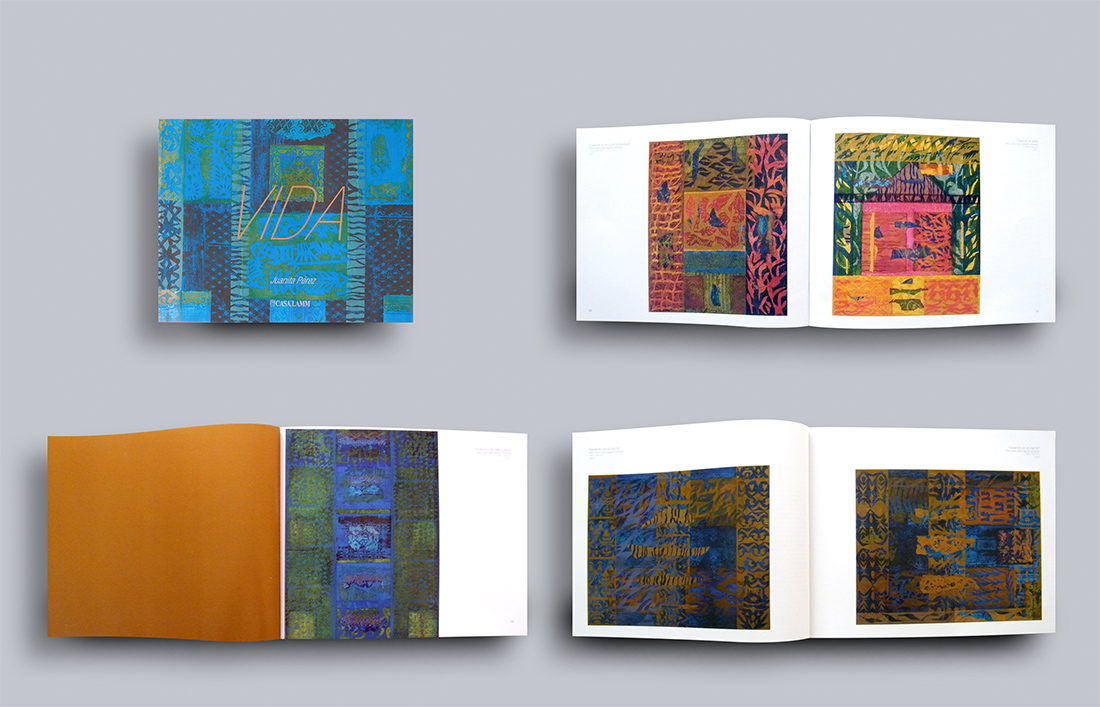- Hilos y Secuencias (Painted Strands)
- Artists of Casa Lamm in their workshops
- Vida
- Casa Lamm and its Artists
- Nombrar las cosas
- Internal Paradises
- Formations
- Desplazamientos
- Art In Embassies Program
- Árboles y Nidos (Trees and nests)
- Tejidos
- Arches-Bridges-Links
- Outside-Inside-Doors
- Ovens
- El ruido del tiempo
Vida
By: Janet DawsonVida
Casa Lamm
January 2012
Confronted with the extravagant abundance of textures, colors, forms, patterns and layers evident in every canvas of Juanita Pérez new body of work: Vida, the viewer is immediately drawn into a vibrant, energized and riveting universe, where the essence of life, as the artist perceives it, unfolds in myriad ways. The stunning impact of these works lies not only in the multi- layered compositions, but also in the powerful energy and movement which emanate from each painting. There is a palpable force which radiates, almost as a magnet, demanding the undivided attention of the spectator, thus encouraging, as always in the artist’s work, the unraveling of those narratives which lie beneath. There is a complex dynamism to these paintings, which most importantly include historical, cosmic and iconographic elements, many of which make references to a rich variety of sources.
One of the most important elements lies in the artist´s fascination with the history and uses of papel picado, which she has chosen to use to symbolize festivals, remembrances, sacred rituals and childhood. The telling of stories, elaborate games, remembrances of things past, are concealed in the intricate patterns and colors of this integral and powerful manifestation of Mexican life. As a foundation for the narratives of Vida, Pérez uses these chiseled swathes of papel picado as the first elements in what appear to be stylized theatrical backdrops; then she has created layer upon layer of abstracted images which dramatically showcase the themes she has chosen to investigate. Such a work is Cometa, where what appear to be swirls of speeding rocket trails, race towards the heavens. This incredible energy and movement is in stark contrast to the series Pedacitos de Cielo where the glimpses of cerulean blue ,are a counterpoint for the elegance, formality and elaborately patterned surfaces belying the power which is such an integral part of each piece.
Helio Oticica´s comment that: “color is the first observation of the world”, could have been written specifically to describe Pérez´s extraordinary color palette in this new series of paintings. While the artist references very specific, and very familiar colors from nature, she simultaneously shocks the eye with totally unexpected combinations, such as acid greens coupled with brilliant magentas, thus begging a redefinition of how we actually perceive our natural world. Her use of multiple colors in the Casas series, for example, reinforces the complex patterning and shapes which surround us on a daily basis, while at the same time inviting us to explore maritime, jungle and celestial environments.
The wealth of botanical references in many of these pieces is accompanied by a sense of vigorous naturalism. There is evidence of her fascination with the beauty of symmetry in nature, together with some its sacred aspects, as exemplified in Árbol mágico con luz de plata, where the statuesque tree, the flatness of its branches and leaves against a complex patterning and dappled silvery light on the golden/ochre background are reminiscent of the ceiba tree which exemplifies the Mayan tree of life: the Yaxche, the axis mundi, the stable world order. And this, after all, is the quintessential essence of Juanita Pérez´s Vida where as viewers we are offered visions of our own lives, seen through a brilliant kaleidoscopes colors, textures and narratives.
The wealth of botanical references in many of these pieces is accompanied by a sense of vigorous naturalism. There is evidence of her fascination with the beauty of symmetry in nature, together with some its sacred aspects, as exemplified in Árbol mágico con luz de plata, where the statuesque tree, the flatness of its branches and leaves against a complex patterning and dappled silvery light on the golden/ochre background are reminiscent of the ceiba tree which exemplifies the Mayan tree of life: the Yaxche, the axis mundi, the stable world order. And this, after all, is the quintessential essence of Juanita Pérez´s Vida where as viewers we are offered visions of our own lives, seen through a brilliant kaleidoscopes colors, textures and narratives.

